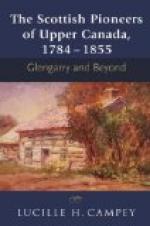[Footnote 1: Funk Island—called by Cartier “the Island of Birds”—is only about 3 miles round, and 46 feet above the sea level. It is 3 miles distant from the coast.]
[Footnote 2: The Great Auk (Alca impennis), extinct since about 1844 in Europe and 1870 in Labrador, once had in ancient times a geographical range from Massachusetts and Newfoundland to Iceland, Ireland, Scotland, N.E. England, and Denmark. Perhaps nowhere was it found so abundantly as on the coasts of Eastern Newfoundland and on Funk Island hard by. The Great Auk was in such numbers on the north-east coast of Newfoundland that the Amerindians of that country and of southern Labrador used it as fuel in the winter time, its body being very full of oil and burning with a splendid flame. The French seamen called it pingouin ("penguin”) from its fatness, and this name was much later transferred to the real penguins of the southern seas which are quite unrelated to the auks.]
Passing through the Straits of Belle Isle, Cartier’s ships entered the Gulf of St. Lawrence. They had previously visited the adjoining coast of Labrador, and there had encountered their first “natives”, members of some Algonkin tribe from Canada, who had come north for seal fishing (Cartier is clever enough to notice and describe their birch-bark canoes). After examining the west coast of Newfoundland, Cartier’s ships sailed on past the Magdalen Islands (stopping every now and then off some islet to collect supplies of sea birds, for the rocky ground was covered with them as thickly as a meadow with grass).[3] He reached the north coast of Prince Edward Island, and this lovely country received from him an enthusiastic description. The pine trees, the junipers, yews, elms, poplars, ash, and willows, the beeches and the maples, made the forest not only full of delicious and stimulating odours, but lovely in its varied tints of green. In the natural meadows and forest clearings there were red and white currants, gooseberries, strawberries, raspberries, a vetch which produced edible peas, and a grass with a grain like rye. The forest abounded in pigeons, and the climate was pleasant and warm.




